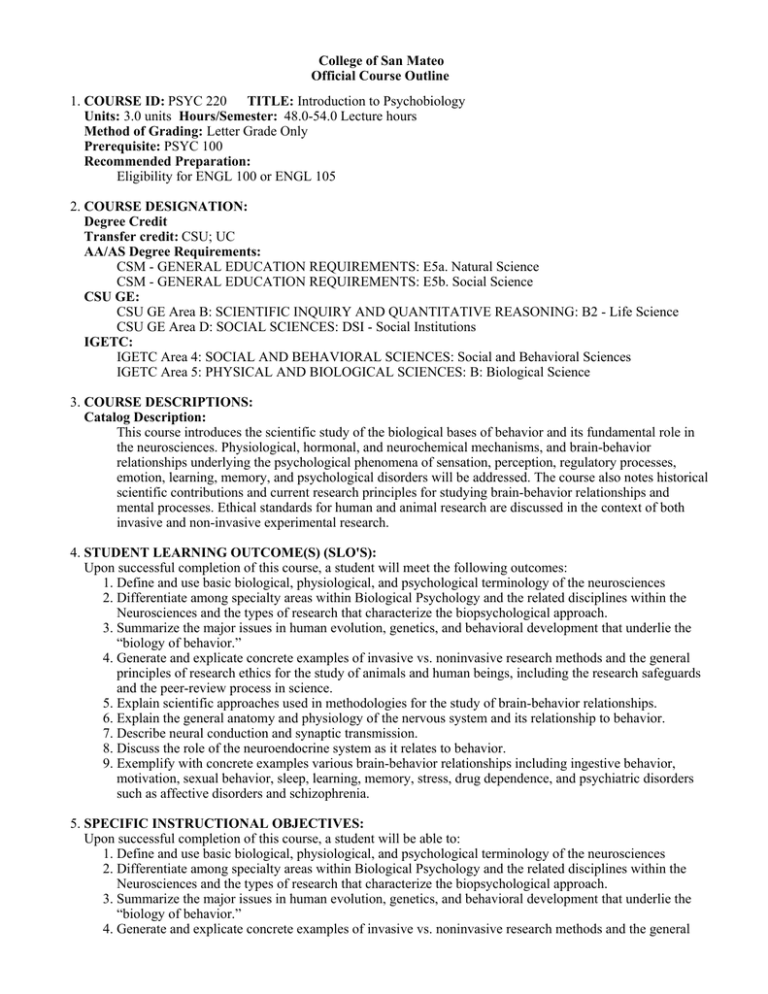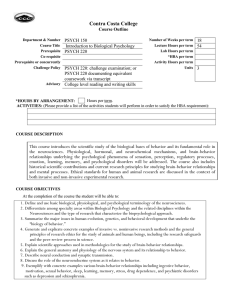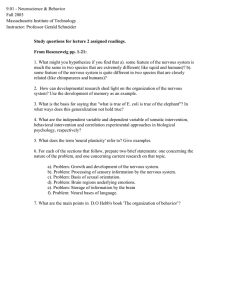
College of San Mateo
Official Course Outline
1. COURSE ID: PSYC 220 TITLE: Introduction to Psychobiology
Units: 3.0 units Hours/Semester: 48.0-54.0 Lecture hours
Method of Grading: Letter Grade Only
Prerequisite: PSYC 100
Recommended Preparation:
Eligibility for ENGL 100 or ENGL 105
2. COURSE DESIGNATION:
Degree Credit
Transfer credit: CSU; UC
AA/AS Degree Requirements:
CSM - GENERAL EDUCATION REQUIREMENTS: E5a. Natural Science
CSM - GENERAL EDUCATION REQUIREMENTS: E5b. Social Science
CSU GE:
CSU GE Area B: SCIENTIFIC INQUIRY AND QUANTITATIVE REASONING: B2 - Life Science
CSU GE Area D: SOCIAL SCIENCES: DSI - Social Institutions
IGETC:
IGETC Area 4: SOCIAL AND BEHAVIORAL SCIENCES: Social and Behavioral Sciences
IGETC Area 5: PHYSICAL AND BIOLOGICAL SCIENCES: B: Biological Science
3. COURSE DESCRIPTIONS:
Catalog Description:
This course introduces the scientific study of the biological bases of behavior and its fundamental role in
the neurosciences. Physiological, hormonal, and neurochemical mechanisms, and brain-behavior
relationships underlying the psychological phenomena of sensation, perception, regulatory processes,
emotion, learning, memory, and psychological disorders will be addressed. The course also notes historical
scientific contributions and current research principles for studying brain-behavior relationships and
mental processes. Ethical standards for human and animal research are discussed in the context of both
invasive and non-invasive experimental research.
4. STUDENT LEARNING OUTCOME(S) (SLO'S):
Upon successful completion of this course, a student will meet the following outcomes:
1. Define and use basic biological, physiological, and psychological terminology of the neurosciences
2. Differentiate among specialty areas within Biological Psychology and the related disciplines within the
Neurosciences and the types of research that characterize the biopsychological approach.
3. Summarize the major issues in human evolution, genetics, and behavioral development that underlie the
“biology of behavior.”
4. Generate and explicate concrete examples of invasive vs. noninvasive research methods and the general
principles of research ethics for the study of animals and human beings, including the research safeguards
and the peer-review process in science.
5. Explain scientific approaches used in methodologies for the study of brain-behavior relationships.
6. Explain the general anatomy and physiology of the nervous system and its relationship to behavior.
7. Describe neural conduction and synaptic transmission.
8. Discuss the role of the neuroendocrine system as it relates to behavior.
9. Exemplify with concrete examples various brain-behavior relationships including ingestive behavior,
motivation, sexual behavior, sleep, learning, memory, stress, drug dependence, and psychiatric disorders
such as affective disorders and schizophrenia.
5. SPECIFIC INSTRUCTIONAL OBJECTIVES:
Upon successful completion of this course, a student will be able to:
1. Define and use basic biological, physiological, and psychological terminology of the neurosciences
2. Differentiate among specialty areas within Biological Psychology and the related disciplines within the
Neurosciences and the types of research that characterize the biopsychological approach.
3. Summarize the major issues in human evolution, genetics, and behavioral development that underlie the
“biology of behavior.”
4. Generate and explicate concrete examples of invasive vs. noninvasive research methods and the general
principles of research ethics for the study of animals and human beings, including the research safeguards
principles of research ethics for the study of animals and human beings, including the research safeguards
and the peer-review process in science.
5. Explain scientific approaches used in methodologies for the study of brain-behavior relationships.
6. Explain the general anatomy and physiology of the nervous system and its relationship to behavior.
7. Describe neural conduction and synaptic transmission.
8. Discuss the role of the neuroendocrine system as it relates to behavior.
9. Exemplify with concrete examples various brain-behavior relationships including ingestive behavior,
motivation, sexual behavior, sleep, learning, memory, stress, drug dependence, and psychiatric disorders
such as affective disorders and schizophrenia.
6. COURSE CONTENT:
Lecture Content:
1. Identifying and critically examining the major historical developments in psychobiology (biological
psychology)
A. Biological explanations of behavior
a. Physiological explanation
b. Ontogenetic explanation: sensitive period
c. Evolutionary explanation: common ancestor
B. Theoretical models of the mind-brain relationship
a. Materialism
b. Dualism
c. Emergent property position
C. Contributions and perspectives of women: Linda Bartoshuk, Sandra Bern, Patricia Churchland,
Marian Diamond, Diane Halpen, Eleanor Maccoby, Margaret Matlin and Brenda Millner
2. Research Methods of Psychobiological investigation
A. Ethical Issues/Invasive vs. Non-Invasive
a. Animal welfare vs. equal rights for animals
b. Are alternative methods feasible?
c. Difficulty of resolving moral issues
B. Methods of research
a. Macro anatomical methods
b. Micro anatomical methods
c. Stereostatic techniques and other surgical methods
d. Introduction to anatomical methods using the sheep brain as a model
3. Basic Anatomy and Physiological Processes of the Nervous System
A. The Cells of the nervous system
a. Neurons and glia
b. Structure of the neuron: soma, dendrites and axon
c. Glia: oligodendrocytes and Schwann cells
d. Development and Plasticity
B. The nerve impulse (communication within the nervous system)
a. Resting potential of the neuron
b. Action potential
c. Propagation of the action potential
d. The myelin sheath and saltatory conduction
C. Synapses and Drugs (Psychoactive Drug Effects)
a. Chemical events at the synapse
b. Sequence of chemical events at a synapse
c. Synthesis of transmitters
d. Release nad diffusion of transmitters
e. Activation of receptors of the postsynaptic cell
4. Comparing and contrasting the major sensory systems
A. Reception, transduction and coding
a. Generator potential
b. Coding: law of specific nerve energies
c. Labeled-line coding vs. pattern across fibers
B. Audition
a. Structures of the ear
b. Pitch perception
c. Deafness
d. Localization of sounds
C. The chemical senses
a. Taste: receptors and paths to the brain
b. Olfaction: olfactory cells and cilia
D. Vision
a. Visual receptors: rods and cones
b. Chemical basis for receptor excitation
c. Neural basis of visual perception
d. Visual processing at higher levels
e. Mechanisms of shape perception
5. Tracing the growth and differentiation of the vertebrate brain
A. Development of the brain
a. Neural tube
b. Central canal of spinal cord
c. Cerebrospinal fluid
B. Pathfinding by axons
a. Chemical pathfinding
b. Competition among axons
c. Pioneer neurons
C. Development of the Visual Systems
a. Infant vision
b. Development of binocular areas
c. Development of pattern perception
d. Development of other aspects of vision
D. Abnormalities of development
a. Mental retardation
b. Genetic causes
c. Exposure to toxic substances
d. Malnutrition
e. Head injury
6. Comparing and contrasting the major biological theories of learning and memory
A. Learning, memory, amnesia, and brain functioning
a. Localized or diffuse representations of memory
b. Classical conditions
c. Operant conditioning
B. Brain damage and human amnesia
a. Korsakoff's syndrome
b. Alzheimer's disease
c. Different types of memory
C. Memory consolidation
a. Head-trauma interference with consolidation
b. Chemical enhancement and impairment of consolidation
D. Role of the hippocampus, amygdale, and frontal cortex
a. Damage to hippocampus in rats
b. Damage to the hippocampus in the primates
c. Two hypotheses of the hippocampus function
E. Mechanisms of storing information in the nervous system
a. Long-term potentiation in the mammalian brain
b. Learning elsewhere in the nervous system
c. The biochemistry of learning and memory
d. Brain and memory in young and old
7. Evaluating the biological basis of emotional behavior and stress
A. Role of the autonomic nervous system in emotional behaviors
a. Sympathetic nervous system
b. Parasympathetic nervous system
c. Measures of autonomic arousal
B. Emotions, autonomic response and health
a. Posttraumatic-stress disorder
b. Psychosomatic illnesses
C. Chronic stress, the immune system, and health
a. Posttraumatic-stress disorder
b. Immune system
D. Schizophrenia
8. Reinforcement, escape and attach behaviors and the brain
A. The limbic system and emotions
B. Hypothalamus, hippocampus, amygdale, septum and cortex
C. Temporal lobe epilepsy
D. Brain activity and reinforcement
E. Fear and anxiety
F. Panic disorder
G. Aggressive behavior
H. Serotonin synapses and aggressive behavior
I. Mechanisms of Perception, Conscious Awareness, and Attention
a. Wakefulness and Sleep
b. Motivation
c. Ingestive Behavior
9. Critically analyzing the contribution of neurological and hormonal factors relating to gender and culture
A. Biological factors relating to gender and culture
a. Brain cortical organization ii. Hormonal influences
b. Aggression
c. Sexual development and behavior
B. Culturally and gender related hemispheric differences
C. Cognitive differences related to brain morphology
7. REPRESENTATIVE METHODS OF INSTRUCTION:
Typical methods of instruction may include:
A. Lecture
B. Lab
C. Discussion
8. REPRESENTATIVE ASSIGNMENTS
Representative assignments in this course may include, but are not limited to the following:
Writing Assignments:
Short in class writing assignments as well as essays and research reports. Students complete original
research reports in APA style under the direction of the instructor.
Reading Assignments:
Weekly reading assignments from the assigned textbook. Psychology research articles (peer-reviewed)
relevant to student or class research projects.
9. REPRESENTATIVE METHODS OF EVALUATION
Representative methods of evaluation may include:
A. Class Participation
B. Exams/Tests
C. Oral Presentation
D. Papers
E. Quizzes
F. Research Projects
G. Written examination
10. REPRESENTATIVE TEXT(S):
Possible textbooks include:
A. James W. Kalat. Biological Psychology, 11th ed. Cengage Learning, 2012
B. John P. J. Pinel. Biopsychology, 9th ed. Pearson, 2013
C. Carlson, Neil. Foundations of Behavioral Neuroscience, 9th ed. Pearson, 2013
Origination Date: November 2014
Curriculum Committee Approval Date: March 2015
Effective Term: Fall 2015
Course Originator: Kevin Henson




